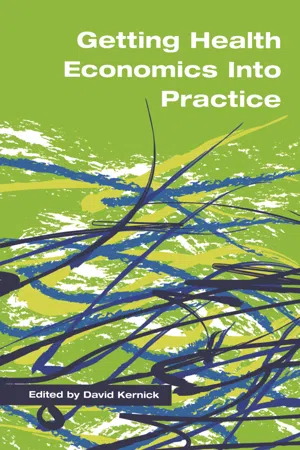
- 168 pages
- English
- ePUB (mobile friendly)
- Available on iOS & Android
Getting Health Economics into Practice
About This Book
Fifty years ago medicine was straightforward. Doctors had limited therapeutic options and patients did as they were told. Today, an array of medial interventions is putting increasing pressure on limited resources, patients are questioning everything and doctors are uncertain of their role. Health economists hoped to offer important insights to aid decision making, but their technical frameworks bore little resemblance to the practical requirements of end users. Now, this book presents the concepts and insights that health economics has to offer in a way that is accessible to every healthcare decision maker. Getting Health Economics into Practice is for all those who are involved in the planning, commissioning and delivery of healthcare. It illuminates the practical value that the concepts and principles of health economics can offer decision makers at all levels. Comprehensive and extensive, it is the first such book to be edited by a clinician rather than a health economist, with contributions from an expert panel of specialists. This approach ensures it is accessible and useful in the everyday work of health professionals. It is relevant for all healthcare sectors, in particular for Primary Care Trusts, and is essential reading for managers, researchers, and especially practitioners.
Frequently asked questions
Information
Section 1
Getting to grips with the basics
CHAPTER 1
An introduction to health economics
Key points
- Health economics is a subdiscipline of economics and is exerting an increasing impact on decisions in healthcare at every level.
- There are two distinct branches of economics and this distinction is carried through into health economics. One uses economic theory to explain and predict the operation of the health system. The other uses theory to facilitate decision making from a perspective of making the most efficient use of limited resources.
- Economic theory takes as its starting point the thesis that the most efficient way to distribute resources is using a market where individuals act rationally to maximise their satisfaction.
- The difficulties of applying this model to healthcare is well recognised, but its importance is that it provides useful insights into how healthcare can be organised and financed and it can provide a framework to address a broad range of issues in an explicit and consistent manner.
- Other inputs enter the decision-making process in healthcare such as equity and public opinion. These considerations can conflict with efficiency.
- Health economics has been slow to be adopted in practice due to a gap between health economic theory and the conflicting directives and pragmatic requirements of policy makers, managers and practitioners.
Chapter sections
- What is health economics?
- What drives health economists?
- What do health economists get up to?
- Conclusion
What is health economics?
- What goods and services shall we produce?
- How shall we produce them?
- Who shall receive them?
The basic economic model
- What does happen?
- What will happen?
- What would we like to happen? (For this stage, objectives need to be defined and values made explicit so that judgements can be made about what is right or wrong.)
- How can we make it happen using insights from our model?
- Resources are scarce and sacrifice is inevitable.
- The best way of distributing society’s limited resources is using the model of a competitive market where decisions are determined by independent consumers and producers using signals in the form of prices regulated by the interplay of supply and demand.
- Each individual has preferences regarding the outputs of any given economic activity that can be ranked by priority and assigned utilities - quantitative measures of their ranking.
- People act as individuals and act so as to maximise their satisfaction or utility.
- The well being of society is reflected in the sum of the utilities of its individual citizens.
- There may be an uncertain relationship between the consumption of healthcare and health.
- Consumers do not have accurate information to allow them to make choices about their consumption of healthcare.
- There may be a reliance on clinicians to make choices on behalf of their patients, but these same clinicians as suppliers may have vested interests such as financial incentives.
- Consumers are not independent of each other’s actions. Often, one individual’s consumption of healthcare (e.g. immunisation) impacts on the health of others in the community.
The two branches of health economics - descriptive and prescriptive
Table of contents
- Cover
- Title Page
- Copyright Page
- Contents
- About this Book
- List of Contributors
- Prologue
- Section 1: Getting to Grips with the Basics
- Section 2: Aspects of Health Economics
- Section 3: Aspects of Economic Evaluation
- Section 4: Getting Economic Evaluation Into Practice
- Section 5: Health Economics and Rationing
- Section 6: Health Economics: Some Perspectives
- Epilogue
- Glossary
- Useful Resources
- Appendix 1: Studies Assessing the Impact and Relevance of Health Economic Analyses in Practice at Purchaser Levelresearch Focus
- Appendix 2: PBMA or MA Studies at Local Level in the NHS
- Index